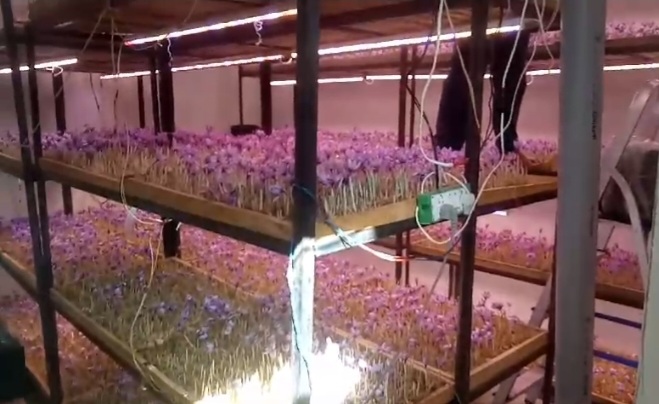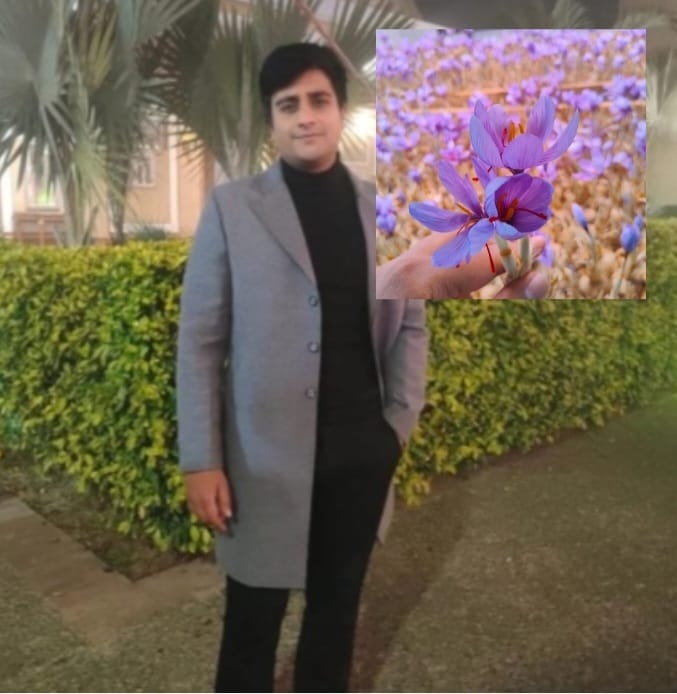Himbumail Editor-in-Chief Kuldeep Chauhan caught up with Yuvraj Bhinta here today, a young visionary from Shimla who’s pioneering saffron cultivation using aerophonics. He means business. He left his lucrative corporate job and instead chooses his ancestral land in Koti village in Baghi, Kotkhai area to find that his dream come true: to provide a new alternative to the apple farmers.
Here, Yuvraj shares insights into his journey, his unique farming techniques, and his vision for saffron production in Himachal Pradesh.
Himbumail: Yuvraj, it’s exciting to hear about your saffron cultivation journey. Can you explain your approach using aerophonics and what makes it special?
Yuvraj Bhinta: Absolutely! With aerophonics, I’m creating an artificial, highly controllable environment where I can monitor temperature, humidity, CO2 levels, and light – all of which are crucial to the successful blooming of saffron flowers.
This setup lets me manage the flowering process almost precisely, aiming for maximum yield.
Himbumail: How do you handle saffron bulbs after they’ve completed the blooming phase?
Yuvraj Bhinta: Once the blooming phase is over, I’ll transfer the bulbs into the soil to promote their multiplication.
In a semi-controlled environment, like a covered basement, they can grow without being exposed to pests and fungal infections.
This step ensures a sustainable crop for future harvests and helps with bulb reproduction.
Himbumail: Why did you choose saffron over other traditional crops?
Yuvraj Bhinta: Growing up here, I saw that while apples and cherries do well, they’re very dependent on weather, which is becoming less predictable.

I wanted an additional crop that could act as a backup, reducing that dependency. Saffron provides a viable, weather-resilient option that can adapt to changing market trends.
Himbumail: How’s the current saffron season going?
Yuvraj Bhinta: It’s in full swing and will continue until the 10th of November. Right now, I’m making sure everything is perfectly aligned for optimal flowering.
Himbumail: What are your plans for selling the saffron once it’s ready?
Yuvraj Bhinta: Saffron is very versatile, and it can be marketed both locally and internationally. I’m considering exporting to Tokyo, where premium-grade saffron is in high demand.
Locally, there’s a big market too, especially among wholesalers. In retail, it fetches around ₹450-₹500 per gram, as people are willing to pay for authenticity – 70% of saffron in today’s market is fake.
Himbumail: Do you plan to focus solely on local sales, or are you exploring bigger markets?
Yuvraj Bhinta: I’m planning a mix. Initially, I’ll sell some locally, then expand. I want to target pregnant women and older adults, given saffron’s health benefits. Proper packaging is key, and I might look for retailers in Delhi or Mumbai to get the product out there.
Himbumail: It’s amazing that you’re trying to create a saffron industry here. Do you see local youth getting involved in this?
Yuvraj Bhinta: Definitely! I want to train the local youth in this new crop. It would give Himachal’s farmers a chance to compete with Kashmir, just like they compete with us in apple production.
The Himachal government has shown interest in promoting saffron production here, and with lab-based cultivation, the success rate can really increase, giving new hope to farmers.
Himbumail: Where do you source your saffron bulbs, and what kind of conditions do they need?
Yuvraj Bhinta: For the bulbs, we mostly rely on vendors from Kashmir or other aerophonic farmers outside the region. After flowering, the bulbs thrive in lower temperatures, so they need the chilling hours Himachal provides.
Himbumail: You mentioned fake saffron being an issue. Could you share more about this?
Yuvraj Bhinta: Yes, fake saffron is a real problem here. Some vendors, like those from Nepal, sell saffron dyed to release color instantly when put in water, while real saffron takes time, releasing a golden-yellow hue.
Educating buyers and offering authentic, lab-grown saffron from Himachal will help us change the game.
Yuvraj Bhinta’s journey is an inspiring example of how innovative techniques like aerophonics can create new agricultural opportunities, providing Himachal with a promising future in saffron cultivation. HimbuMail wishes him good luck.
(Yuvraj Bhinta is son of Raj Kumar Bhinta and Natasha(Janartha) Bhinta, an orchardist family of Koti village in Baghi area of Kothkhai)
"YuvrajBhinta_saffron_HimbuMail"
#KotiBaghi





